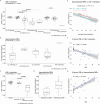Genome-wide DNA methylation profiles of colorectal tumors in Lynch syndrome and familial adenomatous polyposis
- PMID: 40753397
- PMCID: PMC12317532
- DOI: 10.1186/s13148-025-01940-x
Genome-wide DNA methylation profiles of colorectal tumors in Lynch syndrome and familial adenomatous polyposis
Abstract
Background: Lynch syndrome (LS) and familial adenomatous polyposis (FAP) are hereditary cancer predisposing syndromes characterized by increased risk of especially early-onset colorectal cancer. Predisposition to LS is caused by germline mutations in DNA mismatch repair genes leading to elevated cancer progression and microsatellite instability. FAP is associated with germline mutations in APC promoting cancer initiation and chromosomal instability. DNA methylation is an important epigenetic mechanism in early tumorigenesis via, e.g., field defects in non-neoplastic colon. Our aim was to study genome-wide methylation changes in colorectal specimens (adenomas and carcinomas supplemented with paired normal colon) obtained during colonoscopy surveillance, and explore the role of such alterations in tumorigenesis, with a special focus on early changes. To our best knowledge, this study is the first one to compare altered DNA methylation genome-wide in LS and FAP-associated colorectal neoplasia.
Results: DNA methylation alterations were subtle in FAP adenomas, whereas in LS adenomas, changes were abundant when compared to their normal counterparts. When FAP normal and LS normal colon were compared, DNA methylation changes of FAP normal colon mirrored those occurring in LS tumors, suggesting that colorectal tumorigenesis-associated DNA methylation alterations take place already in FAP normal colon mucosa. DNA methylation age was more variable in LS than FAP normal colon, and in proximal than distal colon, when compared to individuals' age at the time of sampling. In LS tumors, DNA methylation changes (hyper- and hypomethylation) were abundant even in adenomas with low-grade dysplasia and stable microsatellites and peaked in adenomas with high-grade dysplasia. LINE-1 hypomethylation was more prominent in LS adenomas than FAP adenomas, but normal colon of LS and FAP displayed similar levels of LINE-1 methylation.
Conclusions: Genome-wide DNA methylation changes are an integral part of FAP and LS-associated colorectal tumorigenesis. Occurrence at early stages, even in non-neoplastic colonic mucosa, and increased prevalence with progressive dysplasia suggest a role in tumor development. Overlap of many of the topmost DNA methylation alterations between LS and FAP, and previous reports of their occurrence in sporadic colorectal and other tumors as well, imply their broad biological relevance and possible biomarker potential for clinical applications.
Keywords: Colon adenoma; Colorectal cancer; DNA methylation; Familial adenomatous polyposis; Lynch syndrome; Tumorigenesis.
© 2025. The Author(s).
Conflict of interest statement
Declarations. Ethics approval and consent to participate: The study was conducted in accordance with the Declaration of Helsinki. All biopsies were taken after patients’ informed consent. The study was approved by the Institutional Review Boards of the Central Finland Health Care District (Dnro 10U/2011, 3.5.2011) and the Helsinki and Uusimaa Health Care District (HUS/390/2021, 23.2.2022). Consent for publication: Not applicable. Competing interests: T.T.S. reports consultation fees from Amgen Finland, Tillots Pharma and Nouscom, being a co-owner and CEO of Healthfund Finland Ltd, and a position in the Clinical Advisory Board and a minor shareholder of Lynsight Ltd. P.P. reports a position in the Clinical Advisory Board of Lynsight Ltd. The other authors declare that they have no competing interests.
Figures





Similar articles
-
Chemoprevention of colorectal cancer: systematic review and economic evaluation.Health Technol Assess. 2010 Jun;14(32):1-206. doi: 10.3310/hta14320. Health Technol Assess. 2010. PMID: 20594533
-
A systematic review and economic evaluation of diagnostic strategies for Lynch syndrome.Health Technol Assess. 2014 Sep;18(58):1-406. doi: 10.3310/hta18580. Health Technol Assess. 2014. PMID: 25244061 Free PMC article.
-
Molecular testing for Lynch syndrome in people with colorectal cancer: systematic reviews and economic evaluation.Health Technol Assess. 2017 Sep;21(51):1-238. doi: 10.3310/hta21510. Health Technol Assess. 2017. PMID: 28895526 Free PMC article.
-
Second malignancies in patients with deficient mismatch repair system/microsatellite instability-high colorectal cancer.Therap Adv Gastroenterol. 2025 Jun 21;18:17562848251347375. doi: 10.1177/17562848251347375. eCollection 2025. Therap Adv Gastroenterol. 2025. PMID: 40547253 Free PMC article.
-
Genetic profiling of inherited colorectal cancer syndromes in Tunisian patients.PLoS One. 2025 Jun 24;20(6):e0326343. doi: 10.1371/journal.pone.0326343. eCollection 2025. PLoS One. 2025. PMID: 40554495 Free PMC article.
References
-
- Kerber RA, Neklason DW, Samowitz WS, Burt RW. Frequency of familial colon cancer and hereditary nonpolyposis colorectal cancer (Lynch syndrome) in a large population database. Fam Cancer. 2005;4(3):239–44. - PubMed
-
- Lichtenstein P, Holm NV, Verkasalo PK, Iliadou A, Kaprio J, Koskenvuo M, et al. Environmental and heritable factors in the causation of cancer–analyses of cohorts of twins from Sweden, Denmark, and Finland. N Engl J Med. 2000;343(2):78–85. - PubMed
MeSH terms
Grants and funding
LinkOut - more resources
Full Text Sources
Medical
Miscellaneous

